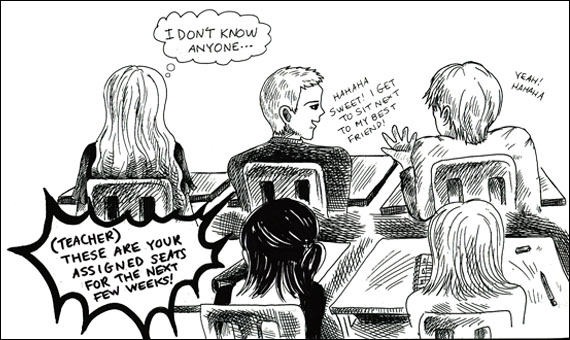
There are many types of seating arrangements that work for different teachers and class environments. Straight-row is the style students most encounter at Aragon. It consists of five to six vertical rows, with five to seven chairs in each. Most of the time, the teachers reinforce the assigned seating arrangements, yet there are some teachers that permit free seating.
Sophomore Edgar Tenorio prefers choosing his seat. “I like it because I can just sit next to people I work better with,” he says. However, this appears to be an unpopular opinion amongst teachers. “I would rather assign them myself, but usually once or twice a year I let [the students] choose, especially if we’re doing a big group project,” says English teacher Jennifer Wei. Science teacher Asif Rahman doesn’t see a problem with free seating, “I let the kids sit wherever they want unless they are misbehaving,” he says.
Sophomore Rachel Andrews is one of the few students who are against the free seating policy. “In Chemistry class we don’t have a seating chart and I was a new kid and I didn’t know where to go. It’s very uncomfortable, especially for kids who aren’t very social.”
Sophomore Claire Luong disagrees, “In the beginning of the year teachers should let students have free seating to understand how people learn better.” Yet Luong understands its challenges. “It can get a bit chaotic when you just want to pass out papers or tests and you don’t know where they are sitting if they are changing their seat everyday. A lot of times people are talking instead of focusing or not really paying attention to the task at hand because they are around their friends,” says Luong, “But I feel more comfortable learning around people I know.” Ramon agrees, “[Free seating] hasn’t been a problem for anybody, and as long as they are behaving, I’m okay with it, and if not, then I’ll move them.”
Most teachers arrange their seats in rows and place students strategically in order to achieve maximum learning potential. Wei only arranges her seats in straight rows when her students are taking individual tests, “I usually put them in clusters because we do a lot of group work,” she says. However, she also adds, “I let people sit where they want and extrapolate my sitting chart from what I believe to be their preferences. If their preferences are romantic, then I guess that’s the universe telling them to be together.” Conversely, Ramon arranges his seats in rows. “I want them to be able to look at the board and be in the most appropriate arrangement to take advantage of that,” he says.
Teachers now have to decide whether personally arranging the seats is the best option or relying on a random generator software. “I think teachers should personally arrange seats [rather than through a software], because then if two people have a conflict or are in love, you can know not to put them next to each other,” says Andrews. Tenorio disagrees, “I think it’s best [for a software to randomly assign seats] because it makes the kids work with someone they might not usually work with. If they get a choice people might choose to work with their friends instead of working with someone they work well which may cause them to not pay attention in class.” Andrews admits that this can be true. “When teachers personally arrange the seats their feelings are involved, and I think that’s a flaw,” she says.
“If you don’t personally organize [the seats] you don’t take into account the things that need to be taken into account,” says Andrews. Wei agrees, “I like to do it myself because I like to seat students who need to be up front as first priority.”
More than just the possibility of using a seating chart goes into creating a focused class environment. The order in which the seats are arranged, as well as the arrangement of students in respect to each other, are important factors in establishing control in a classroom. Students walk into a classroom and know the structure, but they are often unaware of the consideration that goes into making this structure the most beneficial to everyone.




